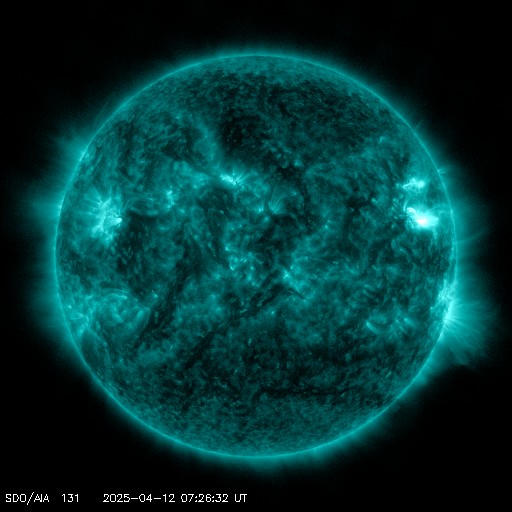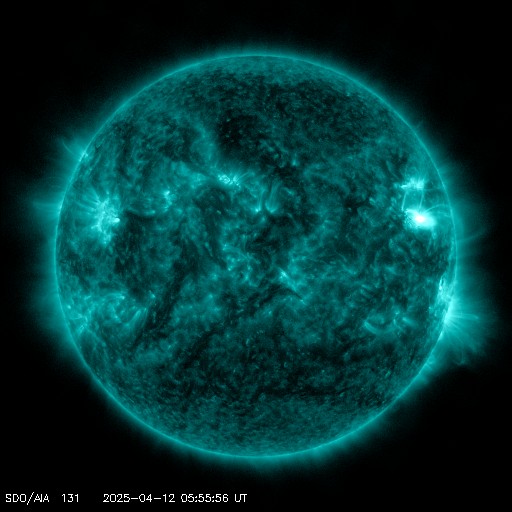Viewing archive of Friday, 18 October 2002
Solar activity report
Any mentioned solar flare in this report has a scaling factor applied by the Space Weather Prediction Center (SWPC). Because of the SWPC scaling factor, solar flares are reported as 42% smaller than for the science quality data. The scaling factor has been removed from our archived solar flare data to reflect the true physical units.
Report of Solar-Geophysical Activity 2002 Oct 18 2200 UTCPrepared by the NOAA © SWPC and processed by SpaceWeatherLive.com
Joint USAF/NOAA Report of Solar and Geophysical Activity
SDF Number 291 Issued at 2200Z on 18 Oct 2002IA. Analysis of Solar Active Regions and Activity from 17-2100Z to 18-2100Z
Solar activity was at low levels. Region 162 (N25E71)
produced the majority of the optically observed flare activity
today, the largest was a C4/Sf event at 18/1927 UTC. The large
cluster of spots seen in white-light appears to be all one region
(based on current available magnetic data) although the regions
proximity to the limb hinders any certainty at this time. Region
149 (N14W46) produced only minor B and C-class flares today.
Magnetic analysis shows the return of the weak gamma magnetic
structure that once again has become apparent. No other significant
changes were seen in the region since yesterday. Region 158
(S08W02) produced a single optically correlated flare, a C1/Sf at
18/0703 UTC. This region retains a beta-gamma magnetic structure
and underwent little change during the period. Newly numbered
region 163 (S21W10) was assigned today.
IB. Solar Activity Forecast
Solar activity is expected to be at
low to moderate levels. Region 162 may have the potential of
producing isolated M-class flares.
IIA. Geophysical Activity Summary 17-2100Z to 18-2100Z
The geomagnetic field activity was at predominantly quiet to
unsettled levels with an isolated period of active conditions
between 18/1500-1800 UTC due in part to the elevated solar wind
speeds (550-650 km/s). The greater than 2 MeV electron flux at
geosynchronous orbit reached moderate levels today.
IIB. Geophysical Activity Forecast
The geomagnetic field is
expected to be at predominately quiet to unsettled levels with a
chance of isolated active conditions on days one and two due to the
elevated solar wind speeds and a favorably positioned coronal hole.
III. Event Probabilities 19 Oct to 21 Oct
| Class M | 40% | 40% | 40% |
| Class X | 01% | 01% | 01% |
| Proton | 01% | 01% | 01% |
| PCAF | green | ||
IV. Penticton 10.7 cm Flux
Observed 18 Oct 173 Predicted 19 Oct-21 Oct 175/175/180 90 Day Mean 18 Oct 182
V. Geomagnetic A Indices
Observed Afr/Ap 17 Oct 008/011 Estimated Afr/Ap 18 Oct 010/012 Predicted Afr/Ap 19 Oct-21 Oct 008/012-010/012-006/008
VI. Geomagnetic Activity Probabilities 19 Oct to 21 Oct
| A. Middle Latitudes | |||
|---|---|---|---|
| Active | 20% | 20% | 15% |
| Minor storm | 05% | 05% | 01% |
| Major-severe storm | 01% | 01% | 01% |
| B. High Latitudes | |||
|---|---|---|---|
| Active | 25% | 25% | 20% |
| Minor storm | 05% | 05% | 05% |
| Major-severe storm | 01% | 01% | 01% |
All times in UTC
Current data suggests there is a slight possibility for aurora to appear at the following high latitude regions in the near future
Whitehorse, YTAnchorage, AK, Fairbanks, AK, Juneau, AK
Latest news
Latest forum messages
AR 4055 39Filaments and prominences 3CME 16Filaments and prominences (old topic) 756Unspecified geomagnetic activity 2239
More topicsSupport SpaceWeatherLive.com!
A lot of people come to SpaceWeatherLive to follow the Sun's activity or if there is aurora to be seen, but with more traffic comes higher server costs. Consider a donation if you enjoy SpaceWeatherLive so we can keep the website online!

Latest alerts
11:18 UTC - Radio Blackout
Minor R1 radio blackout in progress (≥M1 - current: M1.82)
07:39 UTC - Solar flare
Moderate M1.03 flare from sunspot region 4055
07:24 UTC - Radio Blackout
Minor R1 radio blackout in progress (≥M1 - current: M1.03)
06:09 UTC - Solar flare
Moderate M1.27 flare
05:51 UTC - Radio Blackout
Minor R1 radio blackout in progress (≥M1 - current: M1.16)
Space weather facts
| Last X-flare | 2025/03/28 | X1.1 |
| Last M-flare | 2025/04/11 | M1.0 |
| Last geomagnetic storm | 2025/04/06 | Kp5 (G1) |
| Spotless days | |
|---|---|
| Last spotless day | 2022/06/08 |
| Monthly mean Sunspot Number | |
|---|---|
| March 2025 | 134.2 -20.4 |
| April 2025 | 139.5 +5.3 |
| Last 30 days | 136.6 -3.5 |




